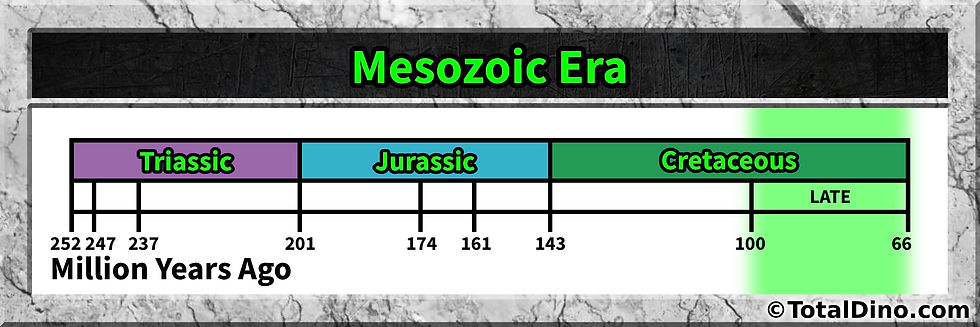Bustingorrytitan
- Total Dino
- Nov 17, 2024
- 3 min read
Updated: Sep 21
MEANING: Bustingorry's giant
PERIOD: Late Cretaceous
CONTINENT: South America
Bustingorrytitan is one of the largest titanosaurs, at around 70 t in body mass. Titanosauria have the largest range of body size of any sauropod clade, and its discovery alongside Argentinosaurus and Chucarosaurus shows an example of convergent evolution, as titanosaurs evolved gigantic proportions multiple times.

Abstract from paper: A new gigantic titanosaur Bustingorrytitan shiva gen. et sp. nov. is described. The four specimens upon which this species is erected come from Neuquén Province, Argentina, from levels of the Huincul Formation (Cenomanian). Bustingorrytitan shiva gen. et sp. nov. exhibits some autapomorphic characters such as posterior dorsal vertebrae with spinodiapophyseal laminae bifurcated in two, very well developed anterior and posterior spinodiapophyseal lamina rami, which limit a deep, vertical, socket-like fossa; posterior dorsal neural arches with forked centropostzygapophyseal laminae; hyposphene in anterior caudal vertebrae; humerus with deltopectoral crest strongly expanded distally; and femur with a low longitudinal crest on the lateromedial half of the anterior face, bifurcated in two minor crests, which are directed to their respective condyles. The phylogenetic analysis performed recovers B. shiva gen. et sp. nov. as a lithostrotian, the sister taxon of Saltasauridae. The estimated body mass is 67.297 metric tons (with a standard error of ±17.228), which makes B. shiva gen. et sp. nov. one of the largest sauropods ever recorded. The record of this new sauropod corroborates the idea that gigantism (evolution of forms over the 50 metric tons) would have evolved many times within Eutitanosauria.
Bustingorrytitan is from the Late Cretaceous. The Cretaceous is the third and final geological period of the Mesozoic Era, with the Late Cretaceous making up roughly the second half of it, lasting from about 100 to 66 million years ago. It was a time of significant evolutionary change, with dinosaurs reaching their greatest diversity before the mass extinction at the end of the Cretaceous.
The Cretaceous was a period with a relatively warm climate, though the Late Cretaceous experienced a global cooling trend, caused by falling levels of carbon dioxide in the atmosphere. The continents were nearing their present positions, but high sea levels flooded low-lying regions, turning Europe into an archipelago, and forming the Western Interior Seaway in North America. These seas were home to a variety of marine reptiles, including mosasaurs and plesiosaurs, while pterosaurs and birds shared the skies.
On land, dinosaurs continued to thrive and diversify during the Late Cretaceous, producing many of the most well-known goups, including tyrannosaurs, hadrosaurs, and pachycephalosaurs. Established Cretaceous dinosaur clades like the ceratopsians, ankylosaurs, and dromaeosaurs continued to flourish. Sauropod species consisted almost exclusively of titanosaurs, which seemed to be confined to the Southern Hemisphere for much of the Late Cretaceous. Flowering plants and grasses diversified and spread, becoming the dominant flora similar to what we see today.
The Cretaceous (along with the Mesozoic) ended with the Cretaceous-Paleogene (K-Pg) extinction event, a large mass extinction in which many groups, including non-avian dinosaurs, pterosaurs, and large marine reptiles, died out. This event, likely triggered by an asteroid impact, is marked by the abrupt K-Pg boundary, a distinct geologic layer separating the Mesozoic and Cenozoic Eras. In its aftermath, mammals and avian dinosaurs rapidly diversified, becoming the dominant land animals of the Cenozoic Era.

Bustingorrytitan is a saltasauroid titanosaur. Saltasauroids are a clade of derived titanosaurs that thrived during the Late Cretaceous and are among the last and most specialized members of the sauropod lineage. They are primarily known from South America, though fossils have also been found in Asia and elsewhere. These sauropods tended to be smaller and more compact than their earlier relatives, with some species estimated to have been under 15 meters in length - small by sauropod standards. Despite their reduced size, they retained the characteristic long necks and tails of their lineage.
One of the most distinctive traits of saltasauroids is the presence of bony armor, or osteoderms, embedded in their skin - a rare feature among sauropods. This dermal armor suggests a possible evolutionary response to increased predation pressures during the Late Cretaceous. Their skeletons often show adaptations toward a more robust and stocky build, possibly indicating changes in locomotion or lifestyle compared to earlier titanosaurs. As one of the last surviving sauropod groups before the end-Cretaceous extinction, saltasauroids represent the final phase in the long evolutionary history of these giant herbivores.













